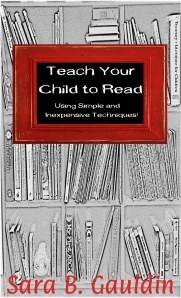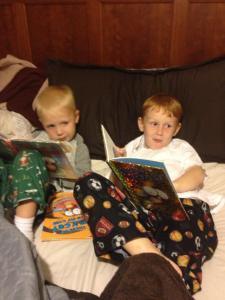Sara B. Gauldin's Blog, page 12
November 21, 2013
My child knows their A,B,Cs!
If your child has been enrolled in a preschool program or has been exposed to television programing that is slotted for early-childhood education (PBS) they most likely have learned to sing along with the alphabet song. I can recall my oldest son singing the song to me as a two-year-old. I was thrilled. I knew my child was a genius! However, he still couldn’t read. Learning the song is a great tool. Many of us still use it as adults when faced with the task of filing or alphabetizing something. The alphabet is just a pretty song until a child can recognize the individual symbols and associate them with specific sounds.
Of course, every child must learn letters. I bought flash cards with each letter embossed with a colorful glossy picture. Hindsight being one hundred percent; that eye-catching picture was trying to tell me something. They represented the sound that the letter made! We spent hours practicing the correct identification of A, a, B, b, C, c and so forth. My smart little boy was naming letters with ease. I was delighted. He would be reading any day! The truth was he was learning, but not all of what he would need to use to utilize the set of symbols to read.
Letter names are great; letter sounds are where the value for achieving literacy lies.
Letter Recognition
Despite the fact that learning to recognize letters did not magically enable my son (or my students) to read, it is still a worthwhile endeavor. If a child can consistently identify letters by their shape and position on the page, he or she is in a much better position to add meaning and utility to that knowledge when they take the process to the next level by adding the sounds that the letters represent.
Try this!
Teach letters as pairs. Show letters as A, a. Children need to understand that both symbols mean the same letter. One is a capital, and one is lowercase, but they are the same letter.
Bring the flashcards back into the picture. This is a valid tool for practicing letter recognition.
Tie letter concepts to writing. Be careful to practice proper grasp of the pencil- this habit is hard to “unlearn.” Begin by tracing letters that are already formed. Commercially produced workbooks are acceptable for this purpose and can be purchased at your local Wal-Mart in the book section. If you would rather produce your own, you can buy or print lined handwriting paper and write the letters yourself, or download the free font at the website listed below that will allow you to type and print properly formed letters using a Microsoft Word document.
Free printable lined paper http://donnayoung.org/penmanship/handwriting-paper-bw.htm
Free font download for Word http://www.fontspace.com/kimberly-geswein/kg-primary-dots
Lower case pintables http://www.alphabetavenue.net/Toons/AlphaToons%20Handwriting%20Practice%20LC.pdf
Upper case pintables http://www.alphabetavenue.net/ABC/Trace%20and%20Write%20Caps.pdf
Other Ways to Learn Letter Names:
Get messy! Cover the bottom of a cookie tray with a thin layer of salt. Help your child to use their finger to draw letters in the salt. Talk about which letter and what parts it needs to have to make the shape correctly. If the letter needs a long line, a short line, a curve or a dot point that out as the shape is made. The tray can easily be reset by gently shaking the tray to spread the salt. This strategy has the potential to hold an active child’s attention.
Another mess producing method is to use shaving cream on the kitchen table. Spray a thin coating of the product directly onto to surface of the table. Guide your child to use their fingers to make the shapes of letters. Make sure to point out the letters name and the key features of each letter’s form. The key to this method and the salt tray is to do this activity with your child. Letting the little one play with the shaving cream or trays with no guidance will guarantee a huge mess and no results.
Use Play dough to make letters. For very young children, the adult involved will need to help by creating “snakes” or long tubes of the dough by rolling the play dough between their hands. Create the shapes of the letters. Talk about what parts the letter needs to make each one correctly. Many children enjoy seeing their own name built in this manner.
Create little swashbucklers! Invest in a foam sword. Occasionally various dollar stores sell these toys. In an open space have your child air carve the letter you call out in the style of the character, Zorro!
Children of all ability levels learn through repeated exposure to the information they need to retain. Have your child view the alphabet on a regular basis. Have him or her touch each letter as they say its name. This chart (http://www.alphabetavenue.net/Toons/AlphaToonsChart.pdf) is a free download. It can be printed on one page and is great for refrigerator display.
After your child has ample opportunity to practice and recite the alphabet it is time to move forward to sequence and matching activities. Create a set of letter cards with capital letters and lower case. Make sure the letters are formed correctly and cut apart. To save time you can download a set of alphabet cards (http://www.teacherspayteachers.com/Product/ABC-sort-835425).
Use the cards to have your child match the capital version of the letter to its lowercase partner. Use either set to practice putting the symbols in order.
Related articles
From Our House to Yours: Letters (campbellsclass101.com)
FUN WITH LETTERS (Weeks of November 18th- November 29th) (tykesofkeswick.wordpress.com)
Learning the Alphabet (ingspirations.com)
Free Alphabet Charts for Preschoolers (ingspirations.com)
{Early Literacy Stage 6} Lowercase letter writing (wildflowerramblings.com)
The Power of the Alphabet (wwang40.wordpress.com)
Top 10 FREE Apps for Learning Letters! (smartappsforkids.com)
Introducing Letters (pumkinsandme.wordpress.com)


November 19, 2013
A Plan of Action – The Release of a New Book
As an independent author, I am continually trying to learn and grow in my abilities to write, format, produce and of course market my books. It sounds pretty straight forward in theory; write a marketing plan, stick to it. Gain reviews, sell books, and then bask in the glory on my success. My experiences with my first book, To Conspire have proven that this is an overly simplistic and naive vantage point that is far from what is required to find a niche in the ever expanding indie market place. I have determined that there are certain truths that stand up, even in the glut of a flooded market.
Quality Product!
One common principle of marketable publication is producing a product that is worthy of the effort and of the readers’ time and energy. I feel that I accomplished that goal with my first book. Although it was a novella, it received positive reviews, even from the strangers who I managed to convince to read it. I would presume that if it was unbearable, these reviewers who do not know me personally or professionally would say so. This being said, I made the decision to seek an editor for my new book, The Corporeal Pull. Alison Jack has put an amazing amount of time and energy into making my book better than my effort alone could produce This book is longer and has a more intricate plot that my novella. I want to ensure that my product is worthy of the market before it arrives there. I hear many references to word of mouth and readers recommending books to one another. I have to admit that most people I know locally are not interested or too busy to read any book. My home town no longer has a book store at all, and the public library has denied membership to anyone who lives outside of the city limits. My take on this is that among circles of people who are active readers, peer recommendation works, but convincing someone who does not typically read to pick up your book, much less recommend it is tricky at best.
Social Media
Another element I see discussed at length is the use of social media. I do see a benefit in using twitter to network with other authors, and occasionally I find a book to read and review there. I have obtained a few sales, but more free downloads in this manner. I also use twitter to give my blog reach and to learn from others in the field. I have a Facebook page; this is probably the least useful social media tool I use. There are a few readers there, but most of the people who follow my page I already know. They are on my personal Facebook page and are no more interested in my writing there. The website Goodreads is a worthwhile avenue to pursue. I read, and review there. I do have an author page, and I talk about my book(s) only in the manner, and format agreed upon in each group.
Promotional Web Sites
There are countless free and paid websites that claim to promote your book. I have tried some of both. My take on this is, any site that claims that they will tweet your book is worthless. I wasted $50 proving this to myself once. The company tweeted my book two or three times. I gained zero sales. As a rule, the majority of followers to these twitter handles are robots which do not buy books (or anything else) because the real followers get tired of being sales pitched and drop them like a bad habit. There are some paid sites that are known to have success, such as bookbub. Most are just looking to make a few dollars at your expense. Think about it; if you are going to buy a book, you will go into a book store or an online book vendor; will you check an ad website first? Most likely not. I advocate using the free sites. Beyond that I say to steer clear.
KDP Select
It is my intention to enroll my new book in KDP select, at least for a period of time. My first book was published in Smashwords to begin with. I learned a lot from the company. They are very user friendly; they give great advice, and they make a modification of a book easy. They also give you the option of expanding your book into many markets and with this broadening of the market its search options increases. The one thing they don’t do is hype your book. There are no advertising options, email follow-up or special free promotion days (although you can set your price to free anytime or create a coupon). This time I plan to submit my book to Amazon first. Later, I may change that plan and offer my book with both vendors as I do now. Either way, it is an experiment.
Book Blogs and Reviews
I am learning to manage book blogs, and hopefully this publication will garner the reviews that I know it deserves. Most book bloggers have blogs (surprise!) however, they are also on social media such as FB, Goodreads, LinkedIn, and Twitter. The key is to keep your eyes open! Personally, I rarely am asked to review books. When I do, I typically receive a free copy (after all, I’m on a budget!)
Press Release
This book will also be worthy of a press release. I will make a formal press release, but it is also my intention to call the local media. I live in a small town, so I feel my book may be viewed as newsworthy.
Many Hats!
There are many other options in my marketing plan. As a self-published author, I have had to learn to be my own staff! I am my creative director, format profession (I was a computer tech. before I was a teacher or an author.), graphic designer (self-taught), blog administrator, marketing director and whatever else need work. At least, this is a better use of my time than video games or television!
Related articles
Part 2 of Bye Bye KDP Select (artistikemwrites.wordpress.com)
10 Steps to Make Goodreads Work For You (writersinthestorm.wordpress.com)
Review of Juniper Grove Book Solutions and YA Bound Book Blitzes (amberskyeforbes.wordpress.com)
7 Top Reasons for Writers to Be on Goodreads (savvybookwriters.wordpress.com)
Which Social Network is Best for Authors? (savvybookwriters.wordpress.com)
8 Ways to Support Author Buddies on a Budget (kourtneyheintz.wordpress.com)
The truth you’ve never heard: why you don’t sell books, why free e-books aren’t killing the market and what Indie Authors do. (procrastinatingwriter.com)
“I have to have a book in my hands” – Digital vs. Print books (thenovelettesblog.wordpress.com)


November 18, 2013
“I know a child that could read when they were four. Is my child behind?”

I wish I had kept an accurate count of the people who have shared this concern with me. As a teacher and as a parent, I realize that every parent wants their child to be advanced. Parents want to feel that their offspring is on the forefront of the developmental curve. Clearly, the child should be advanced; he or she is always doing something wonderful that relates an innate intelligence, so why won’t he or she read?
The honest answer is that reading is a developmental activity, just like learning to walk, speak, potty train or tie one’s shoes. A child’s brain that is not yet developed adequately to perform the tasks involved with reading will have extreme difficulties with achieving that goal at that point in development. The four-year-old child likely is a bright, intelligent individual who will be a fabulous reader when his or her brain has sufficiently developed and has been exposed to a reasonable amount of productive activities. This in no way infers that parents should sit idly by in hopes that the child’s mind will grow, and magically some switch will flip, then they will read; that is not any more realistic than trying to teach a preschooler who is not ready to read War and Peace. Of course you should help your child learn to read! You are your child’s first and best teacher. Ultimately, parental involvement and persistence play a huge role in any child’s academic career.
One more thing to keep in mind; siblings do not always have the same developmental milestones at the same time. They are individuals and have unique strengths and abilities. Try not to give into the temptation to compare your children’s reading ability at a given age to one another!
Let’s get started!
Before a child has any hope of reading anything, groundwork must be laid. For most people the concept that math is a scaffold activity; that it builds on prior lessons, and information is both intuitive and obvious. Reading is just as dependent on building a strong foundation as mathematics yet many people focus on the result of literacy rather than the skills that reading is built upon! There are specific skills and milestones that a child must master before reading becomes possible. Let’s get started!
Begin with a reading test!
Wait! Put the paper and pencils away. This test is much simpler. If you are a concerned parent, you most likely have been reading with your child regularly for quite some time (if not start today!). This time deliberately hand your child a book upside down and backwards. Watch carefully to see exactly what the child does with the book. If they chew on it, accept that your child is a toddler and read them the story. If they open the book and look through the pages, your test is off to a good start. This is where the power of observation will give you a clue about how reading-ready this little person actually is. If the child continues to hold the book upside down and/or backwards and does not seem to notice any difference, then Left to Right Progression is most likely where you need to begin.
There is no magic trick to teaching this skill. Like many tasks in knowledge acquisition, repetition is the key. Read to your child, if possible several times a day. As you read, use your “reading finger” or an object to point to each word as you say it. Make sure you read smoothly from left to right. Pick up your finger or pointer and place it under each word as you progress across the page rather than gliding along under the line. Indicating each word as you say it will help children to begin to distinguish Concept of Word which simply means gaining an understanding that words are distinct entities with their own meaning.
It seems obvious to adults that words are separate until we are faced with a foreign language. Suddenly, the language we are trying to understand by breaking the parts into words is “too fast.” Most individuals learn phrases rather than words and syntax when we attempt to learn a language through direct exposure. Children learn the English language in the same way. They do not hear individual words as much as they learn commonly used phrases. Until a child has gained the understanding that text must be attacked from the left side of the paper to the right, that words are separated by spaces, and that each one has a unique meaning, learning to read is a very difficult task if not an impossible one.
Try this!
From infancy, read with your child regularly! Repeated exposure to good literature has many benefits for your child’s future academic career. Children who learn to enjoy hearing the written word are more likely to enjoy reading in on their own behalf later in life. Hearing the spoken word helps to prepare your child to take in grammar, syntax, story elements and most critically, will develop their vocabulary. Many children who have not developed a strong vocabulary at a young age have a difficult time understanding what they read when they become independent readers. As you read aloud, try not to “robot read.” Children in today’s world are accustomed to being entertained by media and to taking in information passively. This sponge like approach to media does not challenge children or require them to put forth thought. Listening to a story requires a greater mental commitment because they must engage their imagination for the story to “come alive.” You can help your child to become engaged in a story by reading with expression. Give the punctuation the attention it deserves; pause for commas and periods, raise the octave of your voice at the ends of questions, give exclamation points a burst of emotion! Don’t hesitate to give the characters individual voices. If needed, make sock puppets or dress up in costumes with your child to help them to become excited about the book. It is normal and healthy to read children stories that are too difficult for them to read alone; children’s listening comprehension is much higher than their reading ability.
Position the child where they can see the text, not just a glimpse at the illustration; this allows a child to become familiar with the way text looks, and that it is the origin of the story that the reader is saying.
Track the words from left to right using your finger or a pointing tool. By placing your finger or an object under the words as you read your child gradually will become aware that in English, text is read from the left to the right of the page and from the top to the bottom of the page. It is absolutely crucial for children to have a general and intuitive understanding of the order of text before they will be ready to master other literacy milestones.
Pick up your finger and move from word to word rather than gliding. By placing your finger under each word your child will gradually come to understand that each word is a separate thing. Professionals in the field of education refer to this understanding as COW or Concept of Word.
Point out individual words in titles and illustrations and say, “that word says ______.” Again, this skill activity is specifically intended to draw your child’s attention to the fact that words are separate instead of the longer phrases and sentences they hear strung together in spoken language.
Point out the spaces between words. Tell the child that the spaces are where one-word stops and another begins. Spaces are crucial because they are the property lines of written language. Without them writing would be a never-ending series of near meaningless letters strung together as though they were holiday lights on display.
Photo copy a book page or use a coloring book with words. Have the child draw circles around each word. Encourage them to use the spaces to see where one-word stops and another begins.
Ask your child questions about the story. They are able to understand story elements well before they can read them. This will help with reading comprehension later in their development.
Related articles
important early literacy terms that every parent needs to know (teachmama.com)
Why Learning to Read Early is Crucial for Young Children (thetaleofpiggypackfat.wordpress.com)
Starting To Read (orthodoxmom3.wordpress.com)
{Early Literacy Stage 6} Lowercase letter writing (wildflowerramblings.com)
How to Get Your Children Reading Fluently Before Kindergarten (writedge.com)
“How can I help my child learn to read?” (sebgwrites.wordpress.com)
Questions You and Your Child Should Be Asking (makinguswhole.wordpress.com)
10 Rules for Reading Aloud to Preschoolers (psychologytoday.com)
Goodbye illiteracy! (hornbillunleashed.wordpress.com)


November 16, 2013
My Review of Tom from the Future by Rachel Robb

This British themed novella is primed for the young teen reader! I enjoyed the relatable main character, Tom. Tom is an adolescent who is faced with a problem; he believes that his father may be having an affair with another woman. After a period of indecision, he decides to recount his father’s strange and incriminating behavior to his mother. This decision precipitates his parent’s separation. Tom’s relationship with his father becomes increasingly strained following the breakup. Tom blames his father for everything. In an effort to appease Tom, his father arranges a vacation for the two of them. They stay at an old hotel that has the bed and breakfast feel of a converted Victorian home. During his stay, there a series of strange events lead to Tom being continuously awakened in the middle of the night by peculiar sounds. When he attempts to investigate he finds the hotel transformed to the home that it was in the 1800’s. Tom meets the children who lived at the home and helps them to solve a problem that forces him to put his parent’s separation into perspective. The story is touching, captivating and appropriate for young readers!
Related articles
eBook GIveaway!! (angelafrancis.wordpress.com)
Congrats to my ebook distributor and a free Whitey Bulger ebook from WBUR (jmhardinwrites.wordpress.com)
1000 We Like It Big Giveaway (welikeitbigbookblog.wordpress.com)
New Ebook! My First One Ever! (spiraltimes.wordpress.com)
*Book Blitz* + Excerpt & Giveaway: Drowning by Rachel Firasek (bookloverslaceycat.wordpress.com)
Ebook review copies: DRM, distrust, demands (teleread.com)
If the eBook Market is Flattening Out Then Why Are eBook Sales Up at HarperCollins and Hachette? (the-digital-reader.com)
How To Write Your Own Ebook In 7 Days! (imenroll.wordpress.com)
Giving eBooks As Gifts This Holiday Season (teleread.com)
Book Publishers Health Issues (successful-ebook-publishing.com)


“How can I help my child learn to read?”
This question has repeated itself hundreds of times during my professional career. Every parent wants to see their child achieve success, not only in school, but also in life. The truth is that it is absolutely imperative that a child becomes a proficient reader to have the capacity to be a capable student. The link between academic success and being able to function proficiently in the real world is no secret. The actual mystery for many families and even some educators is how to take a wiggly young child and somehow direct them to glean meaning from 52 characters arranged into words.
Almost a decade ago I completed my second term in the halls of higher education. I emerged from college victorious; I had not only earned a degree; I had also secured a teacher’s license from a state whose standards ranked among the highest in the entire country. I was confident. I was brash. I was ambitious. I was hired as a first-grade teacher; and suddenly I was stumped. I envisioned myself boldly changing the lives of young people by granting them access to the Holy Grail that is literacy. I was supposed to be the ultimate holder of the key that would unlock the doors to their education and the potential in their youthful lives.
I can recall that first week of school vividly. Each day, I would begin the school day with “reading” class. I would have the children take out a reading book. I would attempt to have them read from it. I would then have them laboriously tear out a sheet from a workbook and have them attempt busy work. Of course, this was next to useless; they could not read the workbook page any more than they could read the story. In truth, having them compete the page was more of an assessment that instruction. I was supposed to be instructing. I was then that I reached out to my colleagues for help. Thankfully, I was blessed to have a talented array of fellow teachers who were willing and able to listen to my panicked ineptitude and offer me meaningful tidbits of actual instructional techniques that I could apply, and thankfully, I was able to salvage the wreckage of that horrible first week.
Over the years, I have taught hundreds of children reading. I have learned many techniques, and I have worked with an extremely diverse population of students with an incredible array of ability levels, backgrounds and learning styles. During the journey I have discovered that there are some universal truths in the acquisition of literacy. I will share those tidbits and practices that I have incorporated into my classroom instruction over the years so that others can have access to the tips and tools that I had to learn to use on the fly and in the trenches of an early elementary school classroom.
I know that the field of education is continually growing and evolving. New understandings about the way the mind can learn, and fresh research based strategies are created, or renamed and recycled every year. I cannot claim any accolades for the research behind these techniques. I can only relate the experiences I have had while actively teaching young children to read.
I sincerely hope you find this collection of reading tips helpful and find at least a few strategies that you feel you could use!
Related articles
States Insist On Third Grade Reading Proficiency (huffingtonpost.com)
Why Learning to Read Early is Crucial for Young Children (thetaleofpiggypackfat.wordpress.com)
Textbooks recommended by Dept. of Education are full of errors: teachers (nydailynews.com)
Blog entry 7: Taking Reading Seriously (fchen35.wordpress.com)
Instruction for Information Professionals – Library Science 560 Autumn 2013 Training Module Part A (traviscmclark.wordpress.com)
Literacy rates affecting workers’ competence: employers (abc.net.au)
Skills-Based Versus Whole Language Instruction…The Best Approach to teaching Reading & Writing? (theliteracyladder.wordpress.com)
Teacher excellence – discussion board responses for Day 1 (ralphwoh.wordpress.com)
Three New Learnings (joyverbon.wordpress.com)
If You Suspect Your Child Has a Reading Problem (theacademicallyresponsiveparent.wordpress.com)


November 12, 2013
A Few Quick Thoughts
Today I saw snowflakes for the first time this season. I truly hope that this is a snowy winter. I have a million things to do at home, between writing and moving. I have to admit; teachers love snow days as much as students!
It looks like my book; The Corporeal Pull will come home from the editor within the week. I am beyond excited (and a little nervous) to see what Ms. Jack has to say. Either way, a good editing will only help me grow as an author.
I have more exciting news; I received this awesome blog review for To Conspire: http://rainyreviewz.booklikes.com/post/688616/to-conspire- . At this point, I plan to develop that book into a serial type novella. In other words, I plan to write installments like any of your favorite crime dramas on television, only mine will be in book form. I don’t intend to stick to the novel length or trilogy convention with that story line.
I am also working away on my nonfiction book that breaks down the process of teaching a child to read. I have been teaching early elementary students for most of my adult life. As a new teacher, the thing that terrified me the most was teaching reading. How on earth can you teach a child to pick up a book and then to be able to interpret its symbols into meaning? After a long process, I have a firm grasp on the way children learn to read and what methods are effective to bring them to this new phase of academic development. I am breaking down that process into simple steps and useable techniques so that the joy of a good book can be spread to others. I plan on making this book a free selection.


November 11, 2013
The Job
All industry must change with the times. The business in question is under a large amount of public pressure. There is good reason for the intensity of the demand, but the scope of what the industry is capable of producing and the resources at its disposal are grossly misunderstood.
For the sake of protecting the anonymity of this business please envision an office type environment. The office is a professional working environment. The employees are educated individuals. They are required to hold at least a Bachelor’s degree that is targeted to the specifications of each individual’s position and must also undergo extensive testing to obtain certification to be qualified for the position. Unqualified individuals are not hired. There is no working your way up the ladder. The position is stable but there is no room for advancement, ever. The schedule is ridged but allows for family time and has fair vacation leave during specific portions of the year. Aside from the preselected times employees are allowed three personal day per year. Benefits are minimal. Insurance is offered, but family coverage costs more than half of an employee’s take home pay. There is an attractive pension plan that allows for a decent retirement for employees working a full thirty plus years but the budget is tight and there is talk in upper management that this benefit will be reduced or cut for new employees. Of course pay must be a consideration for any job; this business starts at an attractive 30,000 per year. This is a bit lower than the rough average of 50,000 for other graduates with comparable degrees. Of course the selling point here is time with family, stable hours and job security. Are you ready to apply?
Employees must be dedicated individuals, the job involves hours of personal time outside of the typical work day. Work needs to be taken home and completed on a tight schedule. The volume of work tends to increase in direct correlation to time and trendy new methodology that may or not be effective, but will result in an extensive amount of paperwork, new materials being created or purchased and a large amount or research and planning. Typically the work related to a new method is not retired, but will be continued in addition to new methods. Basic materials such as a work space, a desk, a computer and access to a telephone are provided by the company. The employee must provide, procure or create other materials necessary for daily productivity and effectiveness. Other materials that the employees will need to do their jobs include paper, writing utensils, office equipment including staplers, tape, paper clips, wall decor, other decorating motif, literature and any other materials that may become necessary. Employees are expected to provide these materials should they become needed. That application is still available, are you ready to fill it out?
Employees are required to stay current. Some training and continuing education is available. Some of the training must be in the form of qualifying college courses that must be approved by the employer. The employee will incur the cost of these classes. Employees are encouraged, verbally to seek higher level degrees in their field of expertise. In exchange the yearly salary will be raised 1,800 per year. In 23 short years the cost of a 40,000 master’s degree will be recouped by the raised salary of the employee. It is very tempting.
Some job benefits are more internal. Employees will go to work each day with the understanding and expectation that they will make a positive difference in the world. They have the advantage of working with the public in a beneficial way that is not greedy or entitled. The idea that each person has the potential to help another is a substantial way can be highly gratifying. As a career advances a true sense of generativity can be fulfilled. If you want to make a difference in the world, this job is for you!
Productivity is key as with any industry. There is no cookie cutter solution or interchangeable parts. Every situation is unique and requires individual technique, consideration and preparation. Increasingly, situations are complicated by various limitations that cannot be foreseen. Productivity cannot be sacrificed; limitations are no excuse for any form of short coming. The level of effectiveness and rate of exchange should be no different despite and setbacks or limitations. Act now! You can be part of this amazing career!
Working with the public is sometimes tumultuous. The subject matter involved In this industry is sensitive for many people. The public takes less personal responsibility for the well being or success of this industry and those who benefit from it. The public is quick to critique any perceived shortcoming, even if they did not originate for the industry. Rather that coming to the aid of the industry, big bail outs have left this business out of the loop. They are expected to do more with less. And amazingly they do meet success far more often than failure.
A new element has now been added to the job requirements; security. For whatever reason this altruistic industry has been exploited for its vulnerability; the very people it helps. There are some who would seek to harm those who are employed to help, and those that they serve.
Are you ready to take on this exciting new position? Are you excited to find out the jobs title?
You too can join the exciting industry of education, where educated, proficient, socialized and self-sufficient individuals who are destined for greater things and brighter futures are expected to roll off the line, ready for the world at large!
When you see teachers, please see them for what they really are, dedicated, and underpaid civil servants who teach because teaching is a calling. They do receive a paycheck and appreciate job security, but when you think of what they provide, education, security for children who have no stability, moral and behavioral guidelines for life, inspiration, motivation and life perspective in exchange for the knowledge that they made a difference.
Related articles
Teacher Training: do we need it? (annamk73.wordpress.com)
Tips for Teacher Well-being (5j2014misshooban.wordpress.com)
I can’t afford to stay in the classroom (elpasospeak.com)
Vote Set On Next-Step Teachers Contract (newhavenindependent.org)
Solidarity with North Carolina teachers’ walk-in protests (workers.org)
Performance Based Teacher Bash (duckdystopia.wordpress.com)
Unemployed teacher’s warning to a would-be educator: Guest opinion (oregonlive.com)
Teachers need job security? (englishstudies.wordpress.com)
Stressed teachers cost us $10m a year (adelaidenow.com.au)


November 9, 2013
Winter

I enjoy the raw shape of the tree’s skeletal form as the snow adorns it!
Tar black trees contrast
blindingly white snow
with grass peaking through.
No cars, no houses,
only a single smoke spiral
tickling the horizon…
But time marches on
and that one smoke
puff grows into a town…
with people walking
down a frozen street,
shivering, colorful people and
snow draped forms.
A horse and buggy passes
beneath a tree’s skeleton
shrouded with snow over
a slushy walkway.
Only the warm glow
of windows show the warm
heart of the town.
Time marches on
and the small town
becomes a metropolis,
cars and trucks wallow
down snow plowed lanes,
there are no city lights
only dismal gray muffled
by white snow.
People in black bundles
passed by, unimportant.
Related articles
Gloomy Day…Winter Coming… (cynthiabraseth.wordpress.com)
Yay!!!! Snow!!!! (thegirlfrommaine.wordpress.com)
Winter is coming: Freezing temperatures and more than three inches of snow in the north (mirror.co.uk)
Snow Miser Gives Maine A Sampling Of His Winter Menu (moviewriternyu.wordpress.com)
6 Simple Ways to Stay Healthy this Winter (unitedimaging.wordpress.com)


Check out Chapter 1 of To Conspire! Action, Crime and Mystery!
To Conspire is now Available at Amazon for only .99!
Chapter 1
Crime is nothing new in this world. There are daily disturbances, robberies, assaults, and crimes of passion that happen every day. These crimes are pretty straight forward. An addict needs money to fund a fix; they steal. A person feels threatened or scorned; they lash out. There is no great secret motivation in the primal needs that govern the everyday crime. As a beat cop I handled every-day deviants. Well enough to move up the ranks and for me to be transferred here, to Alexandria.
The heat and humidity beats down on the pavement. The dark paved expanse that has replaced the natural red clay has in turn intensified the heat and turned the city itself into an oven. The heat seems to lend itself to the mood of foreboding in the otherwise picturesque city scape. My suit seemed oppressive as I moved at a brisk pace from the car to the station. I brushed a bead of sweat off of my brow as I bundled my chestnut hair into a tight bun. I did not break my stride as I adjusted my tresses.
My phone buzzed angrily in my pocket. It seemed suddenly alive. I shifted my weight to remove it. “Hello?”” I answered in one breath. I did not have time to entertain any interruptions. I was being called to the station in order to be briefed on a case.
“Detective Avery Rich?” a man’s voice demanded.
“This is she.” I answered.
“This is Commander Calbert. I need you to report directly to my office as soon as you arrive.” his voice sounded off. I had not recognized it before he gave a name.
“Err, yes sir. I will miss the briefing?” I rushed here from across town to hear about a series of home invasions. Could he need to talk to me about that? I hadn’t been in town long enough to be second-guessed over a judgment call.
“Never mind that, I am putting you on something else. I already let dispatch know not to reroute you until they hear from me. I’ll see you in my office.” His gruff voice ended abruptly as the call ended in a parting click.
I rushed down the corridor that led from the parking garage into the station. I could not help wondering what the commander had in mind. I had not heard of anything on the dispatch or picked up by the paparazzo that was dramatic enough to have him quite so edgy.
By the time I had reached the commander’s office, I was regretting wearing heels. The idea that appearing a bit taller would garner respect really did nothing but slow me down. There were not enough shoes in Virginia to make my five foot one-inch frame seem more formidable. As I opened the door, the commander stood up. His face seemed flushed. There was a look in his eyes that I had not seen before. The man who had hired me had been calm and composed. This man was more akin to a caged beast.
“We have a situation,” He began “Before I get into details I need to make one thing abundantly clear to you; this is not a case like anything you have experienced before. What I tell you in this room cannot be repeated without my express permission. To do so would jeopardize the entire premise. Until we know the breadth of this, it cannot be shared.”
“Yes sir, I understand.” I lied. I could not imagine anything that could not be shared among colleagues. That was the strength within the police system; collaboration.
“You know that I hired you because you came highly recommended. That is only half of the truth. I also wanted you because you have a reputation for working independently. You are tough. You have a sense of integrity that has not been corrupted by years of work in the streets. And you are not from this area. I needed you here for just this type of situation.”
“Situation Sir?” I was beginning to wonder if Calbert was having a breakdown.
“I need you to go off of the grid for a while. There is a situation here that I cannot open a formal investigation on. It cuts too deep. There are officers here who would be a detriment, and it would take a long time to sort them all out.”
“I understand sir.” Who was I kidding? I was worried about this guy. The stress of the job was clearly getting to him. However, being the newbie, I was not going to be outright disobedient to my CO. No, but I would be cautious. Warned or not, I was not going to step on any toes until I knew what was going on.
Calbert scribbled a name on a piece of paper. “Destroy this when you have found him.” He nodded towards the name he had written. “I think you will find him at the shelter over on Huntington Avenue.”
“He is homeless sir?” I wondered why I would need the help of a vagrant.
“He is unconventionally situated; you will understand why when you meet him.” Calbert’s frazzled appearance did not improve. “You are investigating the disappearance of a bank president, Lawrence Shultz. He was recently named the head of First National Bank. He is the third bank president to disappear in the last month.”
“Has he been entered into the missing person’s database?” I wondered if this was on or off the record.
“He has never actually been reported missing, neither have the others. The first one who disappeared was a good friend of mine, Alan Morris. I noticed he was no longer at his office, ever. I asked at the bank; he was always in a meeting. I called his wife at home. He was always unavailable to come to the phone. However, there was something out of place. His wife’s voice shook when she lied. The teller could not look me in the eye when she reported him as busy. It never let up. “
“You haven’t been able to track him down?” I tried to imagine why the people around this man would be hiding him.
“It is as though he was sucked into a void. There is no sign of him anywhere. I think the word got out that I was asking around. A couple of weeks after I was sure he was not around I got an anonymous call. A female voice called me here at the station from a disposable cell phone and gave a tip that a second banker; Jim Maple was missing. The call came directly to me. The caller was very brief. She sounded terrified. I traced the call and found the phone in a trash can near Fort Ward Park. It was covered in blood.”
“And Shultz, how did you notice he was gone?”
“After the second disappearance that was never reported I started doing some digging. I found out that Mr. Shultz was similarly unaccounted for.” He paused. “I wouldn’t be surprised if there were not more that I haven’t discovered. It is strange. Usually when someone disappears, they are missed. Someone reports them as missing. These are business men, not transients. They have families, careers, or roots here. It is not as though they just wandered to a new town.”
“I’ll get right on it sir.” I could not help thinking that these men may not want to be found. “Oh and sir, this Ryan Kain person at the shelter, how does he tie into this?” Clearly, I was missing something.
“Kain was a good cop. He was one of the best here in Alexandria. Somewhere along the line, the way he saw the world became different from the way the department could work. Some people said he had lost his mind. He seemed to believe that there were forces around him that could not be measured by the casual observer. I suppose some call his kind “conspiracy theorists”.” Calbert betrayed no emotion of judgment.
“Do you think he can help, or do you think he is a suspect?” I was confused. Was I supposed to interview the nutcase or enlist him? “Kain cannot work within the system anymore that much has been proven, but he sees patterns in things that others do not.” Calbert glanced towards the clock nervously.
“Do you mean patterns like missing bankers who are not considered missing?” I ventured.
“Exactly.” he returned.
“I’ll be on my way sir.” I was ready to leave the office before Calbert had a stroke or a heart attack. His face was becoming increasingly red. Sweat broke out around his temples. I wondered what he knew that was upsetting him so much. It crossed my mind that I should be concerned that he did not disclose whatever it was.
As I opened the door to leave, Calbert grunted one last warning; “Keep your head low and be careful.” I would do that much.
As I drove to the shelter, I went over the conversation with Calbert very carefully; three missing bankers who weren’t missing, a homeless crazy man who would be my partner if he would have me, and a mission that I could not call in. The whole situation was a trifecta of odd if you ask me. And to think that the day began with normal, solvable crimes and had already transitioned to an open ended quandary.
I pulled up at the shelter and shuffled through the parking lot to the front door. As I entered the building and approached the front desk I sized up the business. The building was obviously a Christian based establishment. There were posters depicting other projects championed by the nonprofit. It seemed legitimate. The older lady at the front desk greeted me politely; she looked at me and sized me up as police and not homeless right away.
“Can I help you officer?” She asked as she pushed her glasses into place on her nose.
“Detective actually,” I paused. I didn’t need to tell her that, it was pride. I quietly chastised myself as I continued. “I’m looking for someone, a Mr. Ryan Kain.”
“You will find Mr. Kain in the kitchen; he is preparing dinner.” She gestured toward the back of the building.
I made my way down the corridor. As I proceeded, I caught glimpses into the various rooms and pieces of life of that day’s residents. There were all walks of people in the shelter, the young, the old, persons of all races and backgrounds. All of them were here because their lives had taken them in a direction that they did not or could not manage. It was a sad situation. I entered the kitchen. It was full of people all cooking together to make a daily meal for those who would otherwise have none. I had to speak loudly to be heard over the din of clanking dishes, a dishwasher running and the many cooks discussing the menu and how to stretch it a little further.
“Ryan Kain?” I asked.
“That’s me.” The man stepped forward. He was probably in his late thirties; not as old as I had imagined him. He had dark hair cropped short. He wore a button-down shirt and a pair of jeans. I noted that he was an employee, not a resident. His blue eyes twinkled as he stepped forward, but his brow creased in concern.
“I’m Avery Rich, a detective for the Alexandria Metro police. My commander, Calbert, sent me here to ask your help. He said you may see the situation in a way we missed.”
His mouth twisted slightly. “I’m off the force Hun. I have been for quite a while. I can’t help you solve a case.”
“It’s not exactly a case, more of a concern. Is there somewhere we can talk?”
Kain’s eyes widened slightly. He eyed me, as though I had told his deepest secret. “I suppose I could listen to your situation.” I wondered if I should be afraid. He seemed harmless enough.
Kain led me to an office not far from the kitchen. As we entered he glanced nervously out of the blinds.
“Are you alone?” he demanded.
“Yes.” I answered.
“You said Calbert sent you? Who else knows you are here?” he asked.
“No one.” I looked at him squarely in the eye, and he seemed to relax marginally.
“I don’t recognize you, are you new to the force?” He continued.
“No, I’m just new in the area.” I answered.
“Calbert hired you?”
“Yes, he recruited me.”
I was beginning to think this was going nowhere fast. This guy was grilling me like I had committed a crime. “Look, I’m not here to cause you any trouble. I just need to tell you about a situation and see if you have any input. This is all off the books, not even an active case, okay?”
Kain sat down with resolve, “Say whatever it is you came to say.” His voice was cool. His blue eyes no longer sparkled for me.
I recounted the details of the missing bankers, who were not officially missing. I told him about the anonymous call and the bloody cell phone. As I recounted the details, he listened as though he was completely absorbed. As I finished relaying the few details, I had learned Kain stood up and began rummaging in a cabinet. He fished out a map of the city and plopped it unceremoniously onto the desk.
“Show me where, which banks?” he ordered. He held out a pencil. I marked the locations on the map as requested. Kain snatched the map towards him and righted it on his desk. He pulled a ruler from the desk and began an analysis if the document. He drew lines with the pencil. “You do have a problem Ms. Rich.” He began. “Your bankers are most likely dead or being kept alive to elicit information.”
I glanced at the triangle shape he had drawn interposed with another angle and wondered about the other locations he had marked. “You can tell that from the map?” This guy was all kinds of nuts. Why did Calbert send me here?
“Some patterns are evident to those who choose to look.” He quipped.
“Would you like to elaborate?” I ventured.
“Perhaps I will at a later time. For now, we must move along. I suspect the man who has been waiting outside has followed you. You are in danger Ms. Rich. If you will humor me, we need to leave through the back exit immediately.”
“What man?” Was he seeing things now? I stepped over to the window. As I peeked through the slit in the blinds I could see a bald man standing next to my unmarked car. He held a phone to his ear and seemed to be having an intense conversation. As he gestured from my car, then towards the building; he was speaking in the direction of another someone who I could not see. I caught a small glint off of the gun hidden on his belt. Whoever he was he was armed. My hand went instinctively towards my own gun. I ensured that it was ready for action.
“It is best that we leave now Ms. Rich.” Kain prompted. “I must confess that I am not glad that you brought this to my door. Observing these evil movements from a distance is different than involving myself directly, but it seems that I am now involved. I sincerely hope we will both survive the experience.” As Kain spoke he packed. He put some food items and some money into a bag. He pulled out some papers and a disposable cell phone. He took a pack already made up from another cabinet. Last he opened a small hand held safe and reclaimed a hand gun which he attached to his belt.
I followed Kain to the back door. “My car is the black Mazda 6. Go, I’ll cover you!” He tossed me the key and drew his weapon. I drew mine as well. Was his brand of crazy contagious? I opened the door, quickly scanned, and then made a beeline for the car. I threw open the driver’s door and took a protective stance. I looked back at Kain. Was he coming with me or donating his car? Then I remembered the pack of materials he still had slung across his back. His long strides brought him to the car almost effortlessly. For the third time, that day, I regretted my choice of shoes. On the run in heels; this is just great. I slid into the driver’s side and scooted across, handing him the keys as he swung into the seat behind me. The car started quietly and soon we moved smoothly out of the back parking lot and were headed for the freeway. I looked anxiously in the side mirrors to see if we were being followed. Kain tucked and turned as he maneuvered the car in a generally Northern direction. Were we headed to D.C.?
“I’m sorry, but I don’t understand what all of this is about?” I broke the silence.
“It is a rather old story I suppose.” He mused.
“Please fill me in, I feel like I’m missing the big picture. If I am being hunted, I would like to know why.”
“I suppose that would be fair, since you seemed to have been involved in this as unwillingly as I have.” He conceded. As he spoke he turned rather suddenly into the parking lot of a church. We moved towards the back door, and he produced a key from his pocket. He opened the door and held it for me. “After you; Miss Rich.”
“Avery, please call me Avery.” He nodded his acceptance but did not match my attempt at familiarity.


November 5, 2013
A Cultural Glitch
I try to stay away from politics. Sometimes I fail. I will fail today. I will not tell you who to vote for or against. This failure is somewhat deeper in scope and magnitude. Today I am reflecting on the marvelous idea that conceived the democracy that runs our country; such worthy principles that depend on dutiful citizens making conscientious decisions to choose from educated, principled and dedicated civil servants who have the best intentions of the governing body they seek to represent at heart. However, this statement reflects a multitude of problems that will only be resolved through careful education among the voting population.
Where did we go wrong? The majority of our countries problems are cultural in nature. I recently read an editorial published through CNN which cited a poll that collected data about the concerns citizens found the most pressing. There were many legitimate concerns, including the economy, and the jobless rate. I do not take anything away from these concerns. There is a larger problem facing our country, yet it goes unnoticed apart from those individuals who are “in the business.” The business I mention is education. Education is at the root of every major issue our nation faces, yet it is not a noted priority in the minds of the majority of citizens. The article goes on to mention that one in seven adults does not have the reading proficiency needed to read a newspaper article. As a school teacher and an author, I find this disturbing. As a citizen, I find this fact terrifying. We as a country have extended the right to vote to all citizens of legal age. In a world where equality struggles to Eek its way to the surface this is a remarkable thing. Yet we as a population sit in front of our collective televisions and watch political mudslinging that is ripe with jargon and rhetoric. We then send our most uneducated populace forward, fully brainwashed into voting for or against a given candidate. But what does the candidate really represent? And will that candidate act with the best interests of the population he or she represents in mind, or are they there to represent corporate America, the banking industry, or worse of all their own interests for money or power. How many of the voting public are voting blindly. Their rational for choosing a giving candidate may be as objective as pin the tail on the donkey, yet they defend the decision vehemently. Many voters cannot rationalize the choice they make with data, so they vote based on an emotional or moral appeal that may or not be founded.
The solution for this problem is not a simple one. The first step is to fully fund the education system that is now responsible for the only upbringing some children receive at all in these difficult times. Funding the system is not enough. An active media campaign which reinforces the crucial nature of receiving a proper education, that encourages reading and math, and which helps to impart to all citizens the raw importance an educated population represents needs to replace the mudslinging campaigns currently eating away at the judgment of the population like a cancer. Yes, I am supporting the use of propaganda. Advertising is everywhere; there is no reason not to use it to improve the quality of life in our nation.
Another key to improving the cultural and political climate in our country is to implement the equality that we purport to value. (Believe me when I say that I fully advocate equality in all situations, be they related to gender, race, sexual orientation, religion or any other designation.) By this I mean apply taxation to the population equally. I currently pay around one-third of my income to taxes. It would seem fair that all income levels should contribute an equal percentage or sales tax.
The welfare culture cannot be allowed to continue as it currently exists. There will always be elements of the population who need help. The elderly and the disabled should be upheld. Those individuals who are capable of working but choose not to should be required to not only apply and pursue education and employment, but also submit their time and energy for volunteer work. The middle class must earn their keep; the same should apply to those they support. Furthermore, the earned income tax credit should be thrown out. Nobody should revive more tax money back than they paid in as a refund. Rather than awarding tax money in this way, the funds should be returned to Social Security where they were “borrowed” from. Working class American’s paid into this program, it is not a welfare program, but an investment that should never have been put into a position to expire. By changing the expectation of the welfare coverage, and discouraging large family units to drive up welfare costs (perhaps by offering and encouraging use of contraceptives) our society will not continue encouraging the least able to provide for children and offer them the quality of life, they deserve to produce the most offspring to gain income and government benefits. As it is the 2012 census revealed that 21.8 percent of America’s children were living in poverty. Growing up in poverty has been proven to be detrimental to a child’s potential for academic and future success. We cannot buy these children a better future by blindly supporting their parents. We can attempt to change the culture and expectations of those we support through the process of making them into contributing and educated members of society in exchange for the support they receive.
Pet projects and riders on bills are ridiculous and should not be tolerated by the voting populace. A bill should be limited in length, and limited to one specific issue, not an assortment of odds and ends that were slipped in by corrupt politicians. If this plan were implemented, the government would free up billions of dollars that it can in turn utilize to make updates and improvements to our country’s infrastructure and in investments in sustainable and clean sources of renewable energy. Were we as a country to create the technology to power our own county, the need to tedious relationships and lingering and costly wars with oil producing companies would be eliminated. The ending of these give and take situations would ebb the flow of terrorists into our county and save billions more in military spending.
Of course, these changes will only be effective if our government decides to run. The entire concept of a government shutdown is ludicrous. Is our system so broken that it chooses to promote anarchy as a way to manipulate partisan opponents into capitulating rather than compromising? Apparently, that is the exact situation. Again, the voting population has been conned into believing that there is one (or the other) party that is supremely correct and the other is completely wrong. This is a far cry from the way the system was supposed to work. Democracy is designed to work as a system of checks and balances. There have always been parties that represented extreme ideology. There have traditionally been some legislators who fell somewhere in the middle and who served as a voice of reason and compromise between the parties. Over the last twenty years, the media influencing and intimidating voters has led to both parties electing the most extreme among their constituents. These exaggerated opposites have thrown away the hope for reasonable compromise and common sense decision. They bleed money from the system they have sworn to uphold. They focus on pet projects for their own political or financial gain. They allow government shutdown to go unchecked and balance the cost on the backs and economic misfortunes of their largest and most strained tax base, the middle class. This political jockeying cannot be allowed to go one no matter what noble principles they believe they are upholding. The voters (tricked or not) elected them to do a job. The responsibility to represent voters and to SERVE our nation’s government was once viewed as a temporary and noble calling. Now this short term appointment has become a long-term career for those who refuse to do their jobs at all. We as the American people have no choice in this. We are presented with options chosen by a polarized party that only chooses more of the same extremes. Sadly, most voters never hear what these candidates actually stand for or believe. Their voices (if they have any) are lost in the mudslinging of the campaign. Even if a reasonable candidate somehow becomes elected, their contribution is often lost in the partisan jockeying for power. The interests of the people and the reasonableness of a given decision is quickly left behind under the din of the broken machine that is now our government.
















